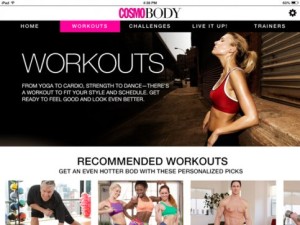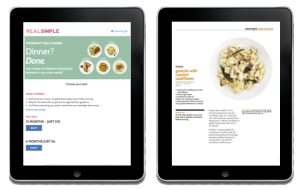Confession: even though I’m a digital guy, I LOVE magazines. When I’m traveling, I usually buy a couple to keep me occupied on my flight. At home, we have a few magazine subscriptions that arrive in our mailbox every month. And any time I’m interested in a new topic (sailing, wine, fitness) I usually fuel my curiosity and buy a few magazines. I love the tactile feel of a magazine in my hands, the glossy large pictures, and both the short articles and the longer in-depth ones. Despite my adoration, there is no dispute that the digital revolution has transformed the magazine publishing industry. The U.S. consumer magazine business has been essentially flat for several years: the market was estimated to be valued at $24.6 billion in 2013, and is projected to be valued at $24.7 billion in 2018. Peeking at the numbers more closely reveals a troubling downward trend. Consumer subscriptions are declining (especially in the younger demographic), and print advertising in magazines is declining rapidly. At one time, the printed magazine was the center and core of a publisher’s business. Today, magazine revenue streams have shifted: in 2004, consumer subscriptions accounted for 34 percent of revenue for U.S. consumer magazines; by 2014, paid subscriptions decreased to only 9 percent of revenue.
This is an industry in the midst of transition, particularly on the digital side of the business. To survive as a magazine publisher in the long-term, these large media companies need to not only shift their advertising revenue to digital, but also seek out new purely digital revenue streams. If I were a Senior Executive at one of the large magazine publishers like Time, Hearst, or Meredith, I would prioritize exploration of new digital revenue streams. I would challenge my company to figure out how to leverage my existing business and brands to open up new digital revenue streams and I would explore what can I learn from others in the industry who have succeeded or failed. With that context, here are 7 tips for magazine publishers to drive digital revenue, along with examples of publishers who are getting it right and others who are still trying to figure it out.
Tip #1: Hone in on demographics before you begin to build a new revenue stream.
This may sound like an obvious place to start, but it’s worth emphasizing how important it is to deeply understand your demographic and their purchasing habits before you experiment with new revenue streams. Let’s take a look at a few examples in the magazine publishing business, starting with a couple that didn’t work out.
Hearst’s Cosmopolitan magazine faced challenges when it launched CosmoBody, an on-demand fitness  channel. At the time, this new subscription cost $9.95 a month and subscribers received workout and lifestyle videos from nationally recognized trainers. The platform was robust, and available via web, tablet, smartphone, and Apple AirPlay. In December 2015, they pulled the plug on the subscription service and the videos are now offered for free on YouTube. So what happened? Cosmo Editor in Chief Joanna Coles noted that the magazine’s audience is “made up of young women with busy work and social lives” and that CosmoBody was “built to work on the go so users can access the workouts and lifestyle content on their iOS and Android devices from any location.” While CosmoBody may have seemed on the surface to be a logical fit for the magazine’s demographic, I believe they failed to consider that this younger millennial audience doesn’t typically have disposable income and are unlikely to buy a digital subscription that costs more than $100 per year. In fact, the $9.95 subscription fee was more than double the printed magazine’s cost of $3.99. That’s a hard sell when comparable content exists for free.
channel. At the time, this new subscription cost $9.95 a month and subscribers received workout and lifestyle videos from nationally recognized trainers. The platform was robust, and available via web, tablet, smartphone, and Apple AirPlay. In December 2015, they pulled the plug on the subscription service and the videos are now offered for free on YouTube. So what happened? Cosmo Editor in Chief Joanna Coles noted that the magazine’s audience is “made up of young women with busy work and social lives” and that CosmoBody was “built to work on the go so users can access the workouts and lifestyle content on their iOS and Android devices from any location.” While CosmoBody may have seemed on the surface to be a logical fit for the magazine’s demographic, I believe they failed to consider that this younger millennial audience doesn’t typically have disposable income and are unlikely to buy a digital subscription that costs more than $100 per year. In fact, the $9.95 subscription fee was more than double the printed magazine’s cost of $3.99. That’s a hard sell when comparable content exists for free.
Hearst’s Good Housekeeping magazine also developed a digital endeavor that ended in a similar fashion. GoodHousekeeping.TV launched in 2015 as a video service that offered free 2-minute how-to videos and 30- to 180-minute paid classes, ranging from $2.99 to $5.99 each. The videos offered tips from experts on cooking, crafting, and DIY projects. However, like CosmoBody, the video service ended in December 2015 and classes are now free on YouTube. I believe this failed for similar reasons: Good Housekeeping readers — with a median household income of $62K — simply weren’t willing to pay for content that they can get for free elsewhere.
Here’s one example that appears to be working: Time Inc.’s Real Simple magazine, which covers topics  such as home solutions, food, organizing, etc., offers a digital weeknight meal planner. For $10 a month, subscribers receive five dinner plans each week with a grocery list organized by ingredients. Subscribers simply buy the food on the list and follow the recipes provided. From my perspective, the meal planner is a relevant extension of something that Real Simple is already doing: they provide smart and simple solutions for educated, busy women. The digital planner is focused on a specific demographic and delivers a solution to a pain-point.
such as home solutions, food, organizing, etc., offers a digital weeknight meal planner. For $10 a month, subscribers receive five dinner plans each week with a grocery list organized by ingredients. Subscribers simply buy the food on the list and follow the recipes provided. From my perspective, the meal planner is a relevant extension of something that Real Simple is already doing: they provide smart and simple solutions for educated, busy women. The digital planner is focused on a specific demographic and delivers a solution to a pain-point.
Magazine publishers have lots and lots of data, so they need to leverage this information to find pockets of their audience that are willing to pay for digital services. Executives should ask questions such as “What problems does my audience need to solve?”, “How often do they need to solve that problem?”, and “Where do they solve that problem now and how much do they spend?” Hone in on your demographic and you’ll be on a path to success.
Tip #2: Separate your editorial team from your technical team.
Publishers who want to explore new digital products should not rely on their editorial team to develop the product offering. When Lucky magazine tried to transition into an e-commerce company, editors struggled with the transition. Instead of handling copy and content, these editors “suddenly felt like saleswomen pushing product.” At one point, the magazine’s editor in chief was juggling several jobs, including “working as a merchandiser, writing copy, fulfillment and other back-end jobs,” and quite possibly filling in for the Chief Operations Officer who had left and was never replaced. At one point Lucky had over 1 million subscribers, but the magazine was shut down in 2015.
As Ariel Foxman, Editorial Director for InStyle and StyleWatch, noted, “The editor’s role is to inspire, to bring the best of what’s new and undiscovered…” Editors are not well suited to manage the complexity of a digital product offering. This requires a completely different skill set. To pave the path towards success, make sure your teams are separate.
You will need to hire someone who has great product vision and has a technical background. Look for someone with years of experience in software product management or leadership. Make sure this person not only knows how to draft a product plan, but also has the ability to assemble a technical team. With a strong leader at the helm, you will be on your way to product success.
Tip #3: Develop digital services that are a natural extension of your magazine’s content.
As you begin to develop digital product concepts, ensure that your ideas are well aligned with your existing reader base. Active Interest Media is a great example of a company that has extended their reach to a robust digital service. One division of the business that’s done this well is The Equine Network which offers several magazines for horse lovers, including Dressage, American Cowboy, and Equus. In addition to their magazine publications, The Network also provides a listing service for selling horses called Equine.com.
The media kit describes the key value of this digital service: “Equine.com is the market leader in connecting buyers, sellers and breeders of horses. Since 1995, our business has been focused on uniting people whose common love for horses fuels a $25 billion per year industry. Our Web marketplace adds tremendous value to the horse industry by providing a unique set of marketing tools that facilitates every horse owner’s dream – whether it’s finding the perfect horse or finding the perfect home for their horse. Combine this with listings for equestrian products, trailers and real estate and you see why Equine.com is known as the premium horse classifieds service on the Internet.” The site boasts that it reaches more than 1.5 million horse owners through the Equine Network and sells more than 20,000 horses per year. The large reach of this digital service puts it in the epicenter of horse owners beyond their magazines’ publications. Consider the Equine Network example and place your readers’ primary interest, needs, and problems at the center as you think about the right digital services to offer.
One nice example of a brand that is doing this well is Allrecipes.com, part of the Meredith Corporation’s  portfolio of magazine and digital brands. Allrecipes is “the world’s number one digital food brand with 18 websites, 2 mobile apps and 14 eBooks serving cooks in 23 countries and 12 languages.” The site helps users find and share recipes, photos, and reviews, and has approximately 30 million global unique visitors each month. One way Allrecipes enhances its digital reach is through the Allrecipes Cooking School, which lets home cooks learn new cooking techniques and tips. Courses start at $15 and users get access to video lectures, study guides, and course content, and get to interact with other students through discussion questions and sharing notes. This is a natural extension of the core site and a great adjunct digital service.
portfolio of magazine and digital brands. Allrecipes is “the world’s number one digital food brand with 18 websites, 2 mobile apps and 14 eBooks serving cooks in 23 countries and 12 languages.” The site helps users find and share recipes, photos, and reviews, and has approximately 30 million global unique visitors each month. One way Allrecipes enhances its digital reach is through the Allrecipes Cooking School, which lets home cooks learn new cooking techniques and tips. Courses start at $15 and users get access to video lectures, study guides, and course content, and get to interact with other students through discussion questions and sharing notes. This is a natural extension of the core site and a great adjunct digital service.
Tip #4: Create a digital offering that feels exclusive.
From a branding perspective, it’s vital that your digital offering feels special and exclusive to consumers. Magazine publishers will be successful if they make their readers feel privileged to join the digital service, as if they’re a member of some private, swanky country club.
A great example of this is Condé Nast’s Style Society, an online community that offers fashion-focused readers an opportunity to share their opinions about style trends and beauty products through surveys, forums, contests, and blog posts. Members receive gift cards and other perks from the Society and get to “swap thoughts and information about fashion with like-minded women.” Entry into the community is selective and they leverage the message “Space is limited and membership is exclusive” to prospective members. A typical Style Society member reads an average of five Condé Nast magazines each month and visits four of the publisher’s websites. The Society helps engage these customers more deeply, and the site generates incremental revenue from advertisers. All of the data from the site including purchase behavior, product testing, and brand perceptions are compiled and sold to select marketing partners.
Here’s another example of a media property that leverages exclusivity: ESPN the Magazine offers Insider which, for $10 a month, gives subscribers digital access to “exclusive analysis and insights, the latest rumors, breaking recruiting news, fantasy tools and custom game simulators.” Many sports fans appreciate real-time updates, behind-the-scenes information on their favorite teams and sports, and the exclusive community that Insider offers.
Think carefully about how to brand your digital products. One potential solution is to combine your existing brand name with an exclusive word such as “Insider” or “Club” or “Clique.” You can communicate a lot about your exclusive offering with the right brand words.
Tip #5: Segment your customer base to determine those willing to pay for your digital offering.
One common mistake that many publishers make when they launch a digital service is to think that the offering should be targeted to all customers. My experience tells me that this is not the right approach. Rather than one-size-fits-all approach, price your digital product in way that will maximize the lifetime value of a new customer. Your goal is not to sell a digital product to your entire customer base, but rather to create an “exclusive insider” product and then find the customers that are willing to pay for the premium offering. You’ll need to build robust price testing into your digital product offering which will require some heavy development, but the long-term investment will be worthwhile.
Astute readers will know that what I’m suggesting is typical pricing segmentation, and there are examples in every industry. For example, the kids party venue chain Kidville also segments their audience using price. Unlike Chuck E. Cheese’s which offers kid’s parties at the low price of $150 to $250, a party of the same size at Kidville will run you anywhere from $895 to $1495. Kidville could certainly offer a much lower price during slow times, but instead they have chosen a price that hones their desired target customer. They don’t want to be a general birthday party venue for all moms. Instead, they have segmented the market in a way that maximizes revenue and focuses on their key demographic (wealthy moms who want the best for their child).
Magazine publishers must take heed: this is the correct strategy when considering new digital product offerings. Rather than pricing your product to appeal to all of your magazine subscribers, you’ll want to devise price testing that will uncover the customers that have a likelihood to pay a higher price. Don’t try to sell a low-priced digital membership to all of your customers. Instead, find the pocket of your subscribers that are willing to pay a much higher price per year. That’s the way to maximize revenue for your new digital business.
Tip #6: Build one technology platform that will support all of your brands/magazines.
Once publishers have determined the correct digital product for each of their magazines, the next step is to build one platform that can support and integrate all of these different types of products. It doesn’t make financial sense to build a platform that’s a one-off job. For example, at Hearst there are 21 U.S. titles and close to 300 international editions — that’s a tremendous investment of time and money. It’s not practical to build a unique back-end to support a digital offering on each brand. Instead, find the back-end components (database, email delivery, payment processing etc etc). that will be common for all brands.
I believe it’s imperative to spend the product development effort upfront with your technical team to abstract shared components. This will take some time, as you’ll need to spend a lot of time listening to your internal customers about their vision for the product and map those to requirements to your technology choices. From my experience, the time you spend upfront will save you at least two times the amount of time on the project. This is an investment that you can easily de-prioritize, but you’ll pay for it in the long run.
As you consider your technology choices, it’s going to be critical to build the service in a way that supports multiple front-ends. You will want to start with a fully-responsive site for all devices (desktop, tablets, and phones) but also consider native apps for iOS and Android. In addition, make sure your technology lead understands your thoughts about pay-as-you-go vs. subscription models so that you make the right technology choices upfront. Don’t take any shortcuts with security or privacy for users. You can have the best new digital product in the world, but if users don’t trust the service you’ll stunt your own growth.
Tip #7: Take the long view about the transition to digital revenue streams.
Last but not least, magazine publishers must be patient when they invest in these new revenue streams. Some of these magazines have existed for 100 years; it’s important for management to remember this and realize that it will take some time to shift gears into digital products and services. The digital world is a completely new territory that is constantly evolving and requires a bit of a learning curve. It’s also something that isn’t necessarily going to have an immediate ROI.
With that said, it’s critical that management set a realistic time horizon for these investments. Currently, publishers evaluate the success of an investment after two to three years; this simply isn’t long enough. Publishers need to use a 5-year model to gauge their investments in these digital products and services, and understand that it will very likely take 10 years to be able to accurately assess a return on investment.
FINAL THOUGHTS: I love magazines, but the publishing industry is in flux and it must adapt to the digital world to prosper and survive in the long run. To date, most of the companies in this industry have simply moved their magazine content online. This isn’t good enough. Consumers of today demand full-featured applications that help them navigate through life and save time. From my perspective, magazine publishers have a huge revenue opportunity — to transition print readers to new digital services and offerings. The golden age of the magazine publisher is now behind us. The companies that nimbly adapt and offer robust digital services will be the dominant companies of the future.


 September 21, 2016
September 21, 2016
